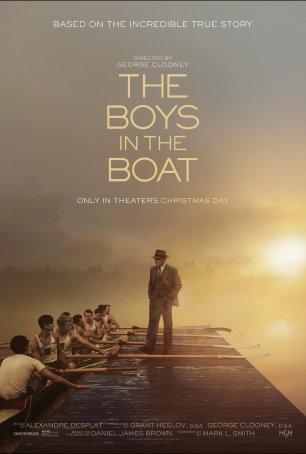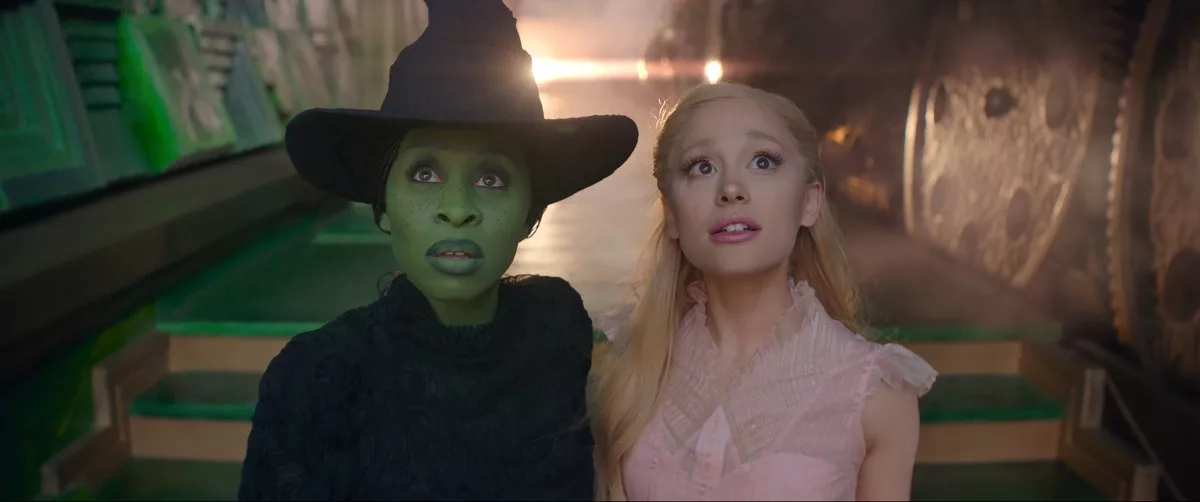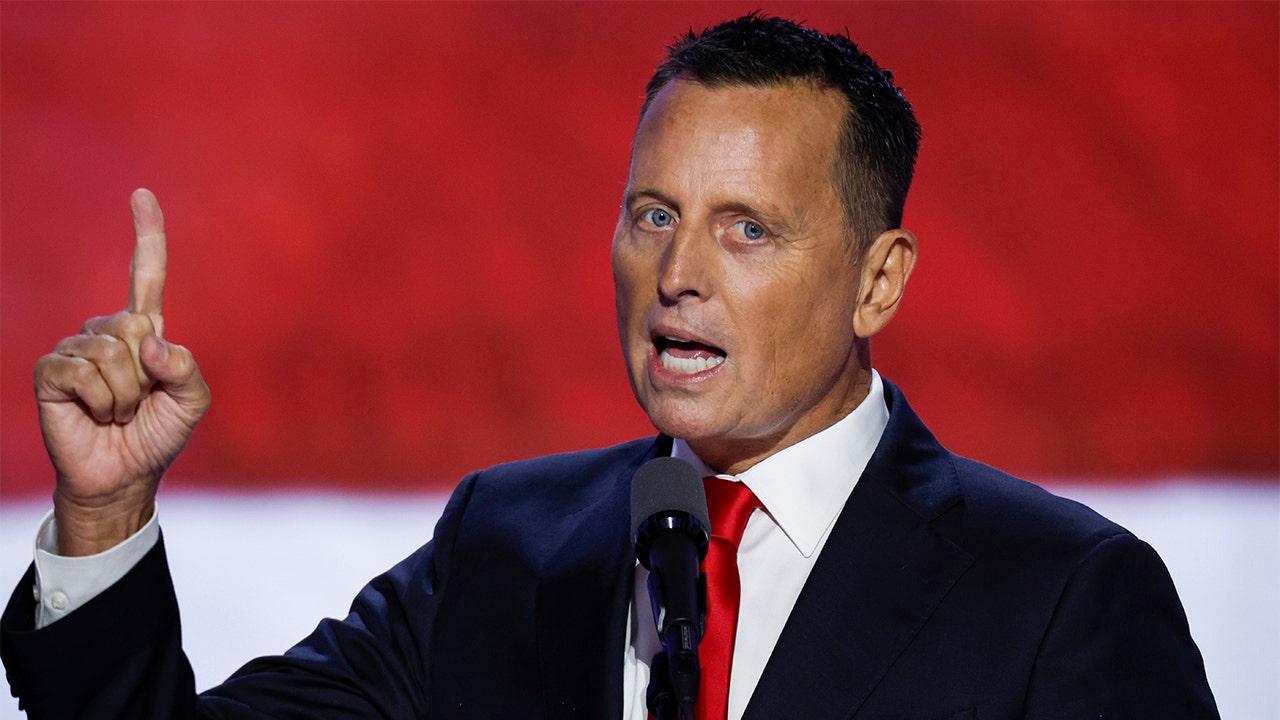Movie Reviews
Boys in the Boat, The | Reelviews Movie Reviews

The Boys in the Boat is an old-fashioned, uplifting
story about the triumph of underdogs. The film radiates the same level of classiness
often associated with its director, George Clooney. Sentimental without being
saccharine, this based-on-history account of the victory of the U.S. rowing
team at the 1936 Berlin Olympics offers likeable characters in a
well-structured narrative that never becomes bogged down by extraneous
elements.
Mark L. Smith’s screenplay relies heavily on the source
material, Daniel James Brown’s 2013 account of how an unsung University of
Washington J.V. rowing team ascended to the upper echelon of the sport, winning
a gold medal with Adolf Hitler in attendance. Because those Olympics are
remembered primarily for the images crafted by Leni Riefenstahl in Olympia
and the triumphs of Jesse Owens, the victory of the rowing team was for many
years regarded as a footnote. That changed with the success of Brown’s book,
which ascended to #1 on the New York Times Bestseller list. Although the
movie rights were quickly optioned (with Kenneth Branagh attached as director),
it took a decade for a film to reach movie theaters.
The book The Boys in the Boat offers a two-pronged
approach to the climactic Olympic contest that took place from August 12-14,
1936. To streamline the film’s narrative, the backstory related to the Nazi
preparation for the games has been elided, resulting in a focus on the
University of Washington’s team as seen primarily through the eyes of one of
the rowers, Joe Rantz (Callum Turner). Although several of the other eight
“boys in the boat” are given moments to help differentiate them from one
another, Rantz is the lone rower with a fully developed character. The only
other three-dimensional individual is Coach Al Ulbrickson (Joel Edgerton). Aside
from Joyce Simdars (Hadley Robinson) and Hazel Ulbrickson (Courtney Henggeler)
– token roles as Joe’s girlfriend and Al’s wife, respectively – there are no
women to speak of.
The curtain rises on 1935 Seattle, with the world mired in
the depths of the Great Depression. Joe Rantz, a student at the University of
Washington, is facing expulsion from college due to an unpaid tuition bill.
Unable to find a job and with day work at a premium, he decides to try out for
the school’s rowing team after learning that participants are given paid
part-time positions. Of the hundreds of would-be rowers, only eight are
selected following a grueling series of try-outs. Joe is one of them. With his
economic issues at least temporarily resolved, he settles into bonding with the
eight other young men in the J.V. boat as they develop into what would become,
in the coach’s words, the best team he has ever seen.
The movie’s sports elements are impeccably recreated; even
those who know the ending (as a matter of the historical record) will find an
element of suspense in the way Clooney frames them. He does this not by
fast-cutting or overly relying on editing but by clean, clear shots both at the
boat level and from above. Winning becomes important because we are invested in
Joe, who at one point states that being on the team is all he has.
Although The Boys in the Boat doesn’t have a
political agenda, it makes a point of acknowledging Jesse Owens’ importance to
the Olympics. Owens doesn’t have a large role in the film – to give him one
would unbalance the narrative and take the focus away from the main characters
– but he notes that he’s in Berlin not so much to thumb his nose at the Germans
but to prove something to everyone back home who doubted him.
Tonally, The Boys in the Boat is a relatively low-key
affair, lacking the overt melodrama that characterizes many sports movies.
Nevertheless, in part because of a strong lead performance by Callum Turner,
solid supporting work from Joel Edgerton and Peter Guinness (as George Pocock,
the boat-builder), and a well-honed screenplay, the film engages viewers on its
intended level. The period detail is evocative but not overbearing and there
are no forced allegories. Offering inspiration in both the truth of its basis
and the way in which it is presented, The Boys in the Boat is an
antidote to the pervasive cynicism of the modern era.
Boys in the Boat, The (United States, 2023)
Cast:
Joel Edgerton, Joel Phillimore, Thomas Stephen Varey, Wil Coban, Bruce Herbelin-Earle, Luke Slattery, Jack Mulhern, Thomas Elms, Sam Strike, Peter Guinness, Callum Turner, Hadley Robinson
Screenplay: Mark L. Smith, based on the book by Daniel James Brown
Cinematography: Martin Ruhe
Music: Alexandre Desplat
U.S. Distributor: Amazon MGM
U.S. Release Date: 2023-12-25
MPAA Rating: “PG-13” (Profanity)
Genre: Drama
Subtitles: none
Theatrical Aspect Ratio: 2.35:1

Movie Reviews
Movie review: Wicked – Baltimore Magazine

There’s been a curious trend in the promotion of movie musicals lately. The trailers and commercials have obscured the fact that they are musicals. This was true of the Mean Girls trailer, which made the film seem like a highly redundant note-for-note remake of the Lindsay Lohan original. And it was also true of Timothée Chalamet’s Wonka, a particularly baffling choice since the original was itself a musical. Both those films did well at the box office but I would argue this was in spite of, not because of the sneaky marketing strategy.
Musicals are having a moment. It’s an extension of fan culture—that is to say, culture—with musical theater nerds loudly and proudly staking their claim among the other fandoms on social media. When I went to see The Outsiders on Broadway, there was a large group of teenage girls screaming for Ponyboy and cheering in anticipatory excitement before all the big numbers. When I caught a preview of The Great Gatsby, the screams were so loud you would think star Jeremy Jordan was Harry Styles.
Certainly among the most enduringly popular musicals is Wicked, the girl-power reimagining of The Wizard of Oz, which made co-stars Idina Menzel and Kristin Chenoweth stars—or at the very least, god tier among musical theater nerds.
Happily, Universal Pictures didn’t try to obscure the fact that Wicked is a musical, but that’s not to say the production was without controversy. Everyone agreed that Cynthia Erivo, who won the Tony for The Color Purple and was Oscar nominated for her turn as Harriet Tubman in Harriet, was perfect for the part of misunderstood witch Elphaba, but mega pop star Ariana Grande as Glinda? When there were deserving musical theater professionals out there in need of a big break? Additionally, the promotion was not above its own bait and switch. Never seen in the commercials and trailer is the fact that the nearly three hour film is merely part one. Part two is due next year.
Let’s get those “controversies” out of the way first. Ariana Grande is a marvelous Glinda—pampered, entitled, but secretly kind—like Alicia Silverstone in Clueless if she had pipes for days. Anyone who has seen Grande on Saturday Night Live already knew she was funny—and here, her stellar comic timing is aided by her adoring sidekicks played with gleeful “you can’t sit here” bitchiness by Bowen Yang and Bronwyn James. As for the film being a part one? I wouldn’t fret it. It ends perfectly. You feel satisfied with what you just saw, while eagerly anticipating the next installment.
So yeah, Wicked is good. Almost great, although I couldn’t quite warm up to all the CGI sets and backdrops. I understand that director Jon M. Chu worked hard to create a built environment, even going so far as to plant 9 million tulips to recreate Emerald City (reader: I thought they were fake). But, despite his best efforts, the film still has that slightly glossy, uncanny feeling of AI. Give me cheesy, hand-built sets any day.
Still there’s a lot to recommend here, as the film is filled with wit and cleverness and verve. Erivo, as expected, makes for a heartbreakingly vulnerable, yet fierce Elphaba, and her belting out of “Defying Gravity” feels like cinematic catharsis at its finest. There are also excellent supporting turns, including Jonathan Bailey as the dashing but romantically conflicted Fiyero; Michelle Yeoh as the glamorous professor of the dark arts, Madame Morrible; the voice of Peter Dinklage as the wise and kindly goat professor, Dr. Dillamond; and Jeff Goldblum as the Wizard. (I mean, of course, Jeff Goldblum is the Wizard of Oz. It’s casting as inevitable as it is perfect.) Also, look out for a few smartly placed cameos. (Can you say: Adele Dazeem?)
Directed and performed with flair and obvious affection for the source material, Wicked is a wickedly good time at the movies. And yes, I imagine it’s going to be popular, as I’m already thinking of shelling out 15 bucks to see it again.
Movie Reviews
Superb reviews and a good opening for Nazriya’s Malayalam comeback film | Latest Telugu cinema news | Movie reviews | OTT Updates, OTT

Suspense thriller Sookshmadarshini marks Nazriya’s return to Mollywood after a hiatus of four long years. Directed by MC Jithin and starring Basil Joseph as the male protagonist, the movie hit the big screens yesterday. Sookshmadarshini received glorious reviews from critics and is off to a good start at the box office.
In Kerala this Nazriya Nazim starrer collected in the vicinity of Rs. 1.6 crores gross, which can be termed as a promising start. The occupancies picked up in the evening and night shows once the reports started coming in. Even though the film had a limited release in the USA, it raked in over $30K on the opening day. The showcasing is expected to increase in this territory from today. Globally, the movie earned approximately Rs. 4 crores gross.
Riding on the terrific word of mouth, Sookshmardarshini commenced its day two with a bang. The movie is now selling around 7K tickets per hour on the BMS portal. Said to be made on a shoestring budget, the film has a high chance of emerging as a blockbuster. Sooskhmadarshini will have a solid weekend, but its performance on the first Monday will give us an idea about the final numbers.
Sookshmadarshini is bankrolled by cinematographers Shyju Khalid and Sameer Tahir, along with AV Anoop. The movie also stars Deepak Parambol, Sidharth Bharathan, Merin Philip, Akhila Bhargavan, Pooja Mohanraj, and others in pivotal roles. Christo Xavier composed the tunes.
Movie Reviews
‘Flow’ Review: Dogs and Cats … Swimming Together … Moist Hysteria!

There comes a moment in every animal lover’s life where we’re watching a movie with a cat in it, or a dog, or an [insert animal here], and we’re overwhelmed by one singular thought: “I swear to god, if anything happens to this creature, I will never watch a movie again.”
It’s an empty threat — probably — but in the moment nothing could be more sincere. Animals have a way of cutting through our emotional defenses. They can be jerks (my cats are literally punching each other right now) but they don’t screw each other over for money. They don’t pass legislation to deny people access to public bathrooms. In the movies, a human being is able to lose our sympathy completely, to the point that something bad happening to them feels like karmic justice. But a cat doesn’t deserve any of that crap. Ever. Ever.
So a film like “Flow” is about as harrowing as filmmaking gets, especially if you like cats. Or dogs. Or secretarybirds. Or lemurs. Or capybaras. The movie puts all these little guys in peril very quickly and never lets up. Even the quietest moments of “Flow” are tainted by existential threat. It’s suspenseful and pensive and painful in a way few films strive for, and fewer still achieve.
“Flow,” directed by Gints Zilbalodis (“Away”), tells the story of a cat who lives in the woods in a long-abandoned house. A pack of dogs, all domesticated breeds, roams these woods as well, chasing our little guy down because — well, they’re dogs. One day, all of a sudden, with almost no warning, a tidal wave crashes through the trees, and the danger won’t stop there. The water level is slowly rising, every second, until all the land starts to disappear under the rippling surface.
The only salvation is a small wooden sailboat. The cat leaps into it along with a lemur and a capybara, and they float aimlessly, foodlessly, atop the trees, over mountains, through the last sky-scraping vestiges of human civilization. The dogs come back, and the golden retriever — being a golden retriever — makes friends with everybody. A secretarybird takes pity on them and brings fish, and may even be able to protect them from other airborne predators. Whatever these animals’ differences may have been, even though they’re naturally predators and prey, even they can recognize that in the face of climate change the only way to survive is by working together. Humanity, much to our ongoing shame, would apparently never.
It’s not a subtle message, and any movie that relies entirely on placing animals in peril isn’t subtle either. Gints Zilbalodis doesn’t merely earn our sympathy with these creatures, he practically takes it from us at gunpoint. To be perfectly frank, “Flow” is in many ways a cinematic cheap shot. Sure, it’ll knock the wind out of you, but it’s not like we had any choice. Animals are cute. Animals in danger are an emotional nuclear strike.
Of course, nobody ever said movies have to be subtle. At least, nobody credible. But “Flow” does find subtlety in its little moments, as opposed to its big messages. The major plot points — daring rescues, unexpected alliances, spiritual moments that defy any literal interpretation — are heavy-handed, yet effective. The scenes of a cat, despite its harrowing circumstances, reduced to kittenhood by the allure of bopping a lemur’s swishing tail? Now that’s relatable. That’s life going on, whether we realize it or not.
So where are the humans in “Flow?” Long gone by the time the movie begins, apparently. “Flow” floats through the remains of our society, empty towers to infinity, monuments reduced to aquatic tombs. Our conspicuous absence is depressing, but then again, if it weren’t for us, or at least whoever built the boat these animals are clinging to, there would be no hope for any animal’s salvation. Except of course for the fish. They seem to be having a field day. If they could speak you’d probably hear one of them yell “I’m king of the world!’ before getting munched on by, apparently, the world’s very last cat.
“Flow” is animated in a style that suggests that Gints Zilbalodis plays, and loves, a lot of video games. The simplistic character designs, the bright lighting, the environments filled with tall structures in the distance to keep us oriented. The nature of the world is revealed in action and detail. Its immensity is contrasted with the smallness of the characters, highlighting a breathtaking sense of scale.
“Flow” uses platforming and puzzle-solving elements to push its story forward, and before long you might get a little impatient and wonder when we’re finally going to be allowed to play. We can’t, of course, because in this story humanity is dead. The story is in so many ways about persevering in the face of overwhelming helplessness. We may never get that “Shadow of the Colossus” movie Hollywood kept threatening to make for so long, but “Flow” understood many of the storytelling lessons that particular classic had to teach us.
Zilbalodis’s film makes a powerful double feature with this year’s “The Wild Robot,” which also tells a tale of a harrowing future in which animals have to set aside their instincts and band together to survive. Both films evoke religious imagery, although “The Wild Robot” is very much The New Testament and “Flow” is basically “Noah’s Skiff.” On the surface it may be tempting to suggest that “The Wild Robot,” being the Hollywood studio version, is the less subtle of the two, but that film has complex philosophical conversations that “Flow” can only hint at, and the commitment “Flow” has to imperiling small animals amidst a climate change allegory is anything but understated. The two films make similar points in incredibly different ways; both do a beautiful job of it.
Getting back to my earlier threat that if anything happens to the cat I’ll never watch a movie again — I can’t say everything turns out OK. Because it kind of can’t, and that’s the point. The animals in “Flow” aren’t in control of their circumstances, and it’ll be a miracle if anything — except of course for (most of) the fish — survives this aquatic apocalypse. And if they do, who knows for how long? Then again “Flow” is itself a bit of a miracle, so maybe there’s hope. If not for us, then at least for the innocent creatures who have to live in the crappy world we’ve made for them.
So if anything does happen to this cat, or this dog, or this secretarybird, or this lemur, or this capybara … we have only ourselves to blame.

-

 Business7 days ago
Business7 days agoColumn: Molly White's message for journalists going freelance — be ready for the pitfalls
-

 Science4 days ago
Science4 days agoTrump nominates Dr. Oz to head Medicare and Medicaid and help take on 'illness industrial complex'
-

 Politics6 days ago
Politics6 days agoTrump taps FCC member Brendan Carr to lead agency: 'Warrior for Free Speech'
-
/cdn.vox-cdn.com/uploads/chorus_asset/file/25739950/247386_Elon_Musk_Open_AI_CVirginia.jpg)
/cdn.vox-cdn.com/uploads/chorus_asset/file/25739950/247386_Elon_Musk_Open_AI_CVirginia.jpg) Technology5 days ago
Technology5 days agoInside Elon Musk’s messy breakup with OpenAI
-

 Lifestyle6 days ago
Lifestyle6 days agoSome in the U.S. farm industry are alarmed by Trump's embrace of RFK Jr. and tariffs
-

 World6 days ago
World6 days agoProtesters in Slovakia rally against Robert Fico’s populist government
-

 News6 days ago
News6 days agoThey disagree about a lot, but these singers figure out how to stay in harmony
-

 News6 days ago
News6 days agoGaetz-gate: Navigating the President-elect's most baffling Cabinet pick



















